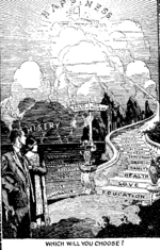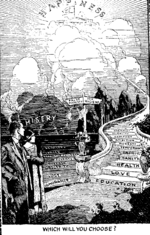
Social hygiene
Encyclopedia

Progressive Era
The Progressive Era in the United States was a period of social activism and political reform that flourished from the 1890s to the 1920s. One main goal of the Progressive movement was purification of government, as Progressives tried to eliminate corruption by exposing and undercutting political...
reformers to control venereal disease, regulate prostitution
Prostitution
Prostitution is the act or practice of providing sexual services to another person in return for payment. The person who receives payment for sexual services is called a prostitute and the person who receives such services is known by a multitude of terms, including a "john". Prostitution is one of...
and vice
Vice
Vice is a practice or a behavior or habit considered immoral, depraved, or degrading in the associated society. In more minor usage, vice can refer to a fault, a defect, an infirmity, or merely a bad habit. Synonyms for vice include fault, depravity, sin, iniquity, wickedness, and corruption...
, and disseminate sexual education through the use of scientific
Scientific method
Scientific method refers to a body of techniques for investigating phenomena, acquiring new knowledge, or correcting and integrating previous knowledge. To be termed scientific, a method of inquiry must be based on gathering empirical and measurable evidence subject to specific principles of...
research methods and modern media techniques.
The social hygiene movement represented a rationalized, professionalized version of the earlier social purity movement
Social purity movement
The social purity movement was a late nineteenth century social movement that sought to abolish prostitution and other sexual activities then considered immoral. Composed primarily of women, the movement was active in English-speaking nations from the late 1860s to about 1910, exerting an...
. Many reformers, such as Dr Marie Stopes
Marie Stopes
Marie Carmichael Stopes was a British author, palaeobotanist, campaigner for women's rights and pioneer in the field of birth control...
, were also proponents of eugenics
Eugenics
Eugenics is the "applied science or the bio-social movement which advocates the use of practices aimed at improving the genetic composition of a population", usually referring to human populations. The origins of the concept of eugenics began with certain interpretations of Mendelian inheritance,...
. Inspired by Charles Darwin
Charles Darwin
Charles Robert Darwin FRS was an English naturalist. He established that all species of life have descended over time from common ancestry, and proposed the scientific theory that this branching pattern of evolution resulted from a process that he called natural selection.He published his theory...
's theory of natural selection
Natural selection
Natural selection is the nonrandom process by which biologic traits become either more or less common in a population as a function of differential reproduction of their bearers. It is a key mechanism of evolution....
, they argued for the sterilisation of certain groups, even racial groups, in society. This link between racial hygiene
Racial hygiene
Racial hygiene was a set of early twentieth century state sanctioned policies by which certain groups of individuals were allowed to procreate and others not, with the expressed purpose of promoting certain characteristics deemed to be particularly desirable...
and social hygiene can be seen in Australia, where the Racial Hygiene Association of New South Wales
Racial Hygiene Association of New South Wales
The Racial Hygiene Association of New South Wales was an Australian based association founded in 1926 by Lillie Goodisson and Ruby Rich of the Women's Reform League. The association was originally known as the Racial Improvement Society until 1928...
is now named The Family Planning Association.
Social hygiene as a profession grew alongside social work
Social work
Social Work is a professional and academic discipline that seeks to improve the quality of life and wellbeing of an individual, group, or community by intervening through research, policy, community organizing, direct practice, and teaching on behalf of those afflicted with poverty or any real or...
and other public health
Public health
Public health is "the science and art of preventing disease, prolonging life and promoting health through the organized efforts and informed choices of society, organizations, public and private, communities and individuals" . It is concerned with threats to health based on population health...
movements of the era. Social hygienists emphasized sexual continence and strict self-discipline as a solution to societal ills, tracing prostitution, drug use and illegitimacy to rapid urbanization
Urbanization
Urbanization, urbanisation or urban drift is the physical growth of urban areas as a result of global change. The United Nations projected that half of the world's population would live in urban areas at the end of 2008....
.
The American Social Hygiene Association was formed in 1913 and later renamed to the American Social Health Association
American Social Health Association
The American Social Health Association , is an American non-profit organization established in 1914 and is dedicated to improving the health of individuals, families, and communities, with an emphasis on sexual health and a focus on preventing sexually transmitted infections and their harmful...
.
The movement remained alive throughout the 20th century and found its way into American schools, where it was transmitted in the form of classroom films about menstruation
Menstruation
Menstruation is the shedding of the uterine lining . It occurs on a regular basis in sexually reproductive-age females of certain mammal species. This article focuses on human menstruation.-Overview:...
, sexually transmitted disease, drug abuse
Drug abuse
Substance abuse, also known as drug abuse, refers to a maladaptive pattern of use of a substance that is not considered dependent. The term "drug abuse" does not exclude dependency, but is otherwise used in a similar manner in nonmedical contexts...
and acceptable sexual behavior in addition to an array of pamphlet
Pamphlet
A pamphlet is an unbound booklet . It may consist of a single sheet of paper that is printed on both sides and folded in half, in thirds, or in fourths , or it may consist of a few pages that are folded in half and saddle stapled at the crease to make a simple book...
s, poster
Poster
A poster is any piece of printed paper designed to be attached to a wall or vertical surface. Typically posters include both textual and graphic elements, although a poster may be either wholly graphical or wholly text. Posters are designed to be both eye-catching and informative. Posters may be...
s, textbook
Textbook
A textbook or coursebook is a manual of instruction in any branch of study. Textbooks are produced according to the demands of educational institutions...
s and film
Film
A film, also called a movie or motion picture, is a series of still or moving images. It is produced by recording photographic images with cameras, or by creating images using animation techniques or visual effects...
s.
See also
- Family planningFamily planningFamily planning is the planning of when to have children, and the use of birth control and other techniques to implement such plans. Other techniques commonly used include sexuality education, prevention and management of sexually transmitted infections, pre-conception counseling and...
- Mann ActMann ActThe White-Slave Traffic Act, better known as the Mann Act, is a United States law, passed June 25, 1910 . It is named after Congressman James Robert Mann, and in its original form prohibited white slavery and the interstate transport of females for “immoral purposes”...
- Racial hygieneRacial hygieneRacial hygiene was a set of early twentieth century state sanctioned policies by which certain groups of individuals were allowed to procreate and others not, with the expressed purpose of promoting certain characteristics deemed to be particularly desirable...
- Reproductive healthReproductive healthWithin the framework of the World Health Organization's definition of health as a state of complete physical, mental and social well-being, and not merely the absence of disease or infirmity, reproductive health, or sexual health/hygiene, addresses the reproductive processes, functions and system...
- Timeline of reproductive rights legislationTimeline of reproductive rights legislationTimeline of reproductive rights legislation, a chronological list of laws and legal decisions affecting human reproductive rights. Reproductive rights are a sub-set of human rights pertaining to issues of reproduction and reproductive health...
External links
- American Social Hygiene Posters - Online repository of social hygiene posters from the University of MinnesotaUniversity of MinnesotaThe University of Minnesota, Twin Cities is a public research university located in Minneapolis and St. Paul, Minnesota, United States. It is the oldest and largest part of the University of Minnesota system and has the fourth-largest main campus student body in the United States, with 52,557...
- The Prelinger Archives at the Internet Archive
- AV Geeks at the Internet Archive

